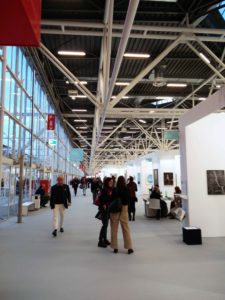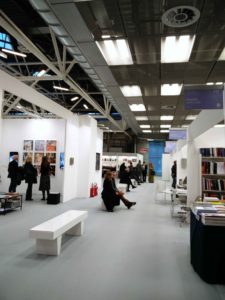 BolognaFiere
BolognaFiere
Piazza Costituzione
Bologna
www.artefiera.it
1 – 4 February 2019
The 43rd edition of the longest running art fair in Italy, was for the first time guided by its new artistic director Simone Menegoi. Even though, he had only six months to prepare the exhibition, he succeeded to give a new momentum to attract a larger public than the last two venues. 50.000 visitors came to see 141 galleries, by tradition, mostly Italian ones, but not only.
– Quality rather than quantity and a clearer structure
– The collateral programme glances to the region
– Contemporary creations besides modern art
– Eye-catchers in the main section
– Photography and sometimes moving images
– More impressions
Quality rather than quantity and a clearer structure
 One remarkable point made by Simone Menegoi, was to encourage galleries to limit the quantity of presented artists with incentives especially to monographic stands. A third of the exhibitors followed this proposal; others showed only two artists. In total, the number of artists was restricted to three for smaller booths and six for the larger ones. This had the effect, that the fair was tidier perceived.
One remarkable point made by Simone Menegoi, was to encourage galleries to limit the quantity of presented artists with incentives especially to monographic stands. A third of the exhibitors followed this proposal; others showed only two artists. In total, the number of artists was restricted to three for smaller booths and six for the larger ones. This had the effect, that the fair was tidier perceived.
This new clarity was also owed to a simpler structure compared to the last exhibition. There were only two subdivisions: the Main Section (128 exhibitors), which presented in one hall primarily Modern and Post-War art and in the other hall notably contemporary creations. The second section was dedicated to Photography and the Moving image (18 exhibitors). Even though this division was open to video, the still images dominated.
The collateral programme glances to the region
Newly introduced was “Solo figura e sfondo”. Davide Ferri as curator united works from public and private institutional collections in Bologna and the Region Emilia-Romagna. The show within the show was subdivided in groups like “Abstract Planes”, “Identity and its Boundaries” or “Fading and Absence”. It was an interesting voyage through divers exhibition spaces, with oeuvres by national and international artists, starting from the beginning 20th century up to the contemporary 21st century. Perhaps this presentation of the local inventory might motivate visitors to attend also some of the collections themselves. This new format is supposed to continue as series entitled “Courtesy Emilia-Romagna”.
no images were found
Another exhibition space was reserved for the Arte Fiera’s homage to Franco Bartoli and Pasquale Ribuffo. The two historic founders of the Bolognese Galleria de’ Foscherari participated and supported the Arte Fiera from its beginnings. The legendary gallery founded in the early 1960s, showed modern artists like Paul Klee, Giorgio Morandi, Max Ernst and George Grosz, but was also interested in research and experimentation in art. In consequence, they collaborated with Piero Manzoni, Christo, Cy Twombly, Concetto Pozzati and others. The American Pop Art was likewise on focus as the Arte Povera. They kept pace with the time and were also attracted by conceptual art of the 1980s. The MAMbo (Museo d’Arte Moderna di Bologna) will extend this homage in a three-month exhibition in its Project Room as of November 2019. Moreover, the late Pasquale Ribuffo was honoured with the ANGAMC Carrer Award for Lifetime Achievement.
no images were found
As part of the official programme, Silvia Fanti curated “Oplà” with performing activities at the fair, on its margins and in the city. One was “Artworks that ideas can buy” by Cesare Pietroiusti. It was a booth similar to others, with two exceptions. At first glance, it was striking that 22 artists were presented here. Moreover, it was not possible to buy the artworks for money, but in exchange for an idea, which could be a comment, an opinion, a proposal, a critic or a suggestion, related to any of the works on view. The written thought and the application for an artwork went in an envelope and into a box. 230 ideas were proposed. At the end of the Arte Fiera, the concerned artist decided whether to accept the offer or not. In the best case, it came to an exchange between visitor and artist.
no images were found
Contemporary creations besides modern art
For the second year, the Fondazione Zucchelli presented artworks by the winners of the foundations contest, selected from the students of the Bolognese Academy of Fine Arts. Interestingly, the booth was situated in the hall with mostly older artworks. Nevertheless, the presented artworks by Li Zhuwei and Daniele Di Girolamo were created recently.
no images were found
Another exception in the same hall was the booth of the Galerie Piero Atchugarry from Garzón (Uruguay) and Miami (USA). With the solo exhibition by Tulio Pinto they attracted a lot of interest in the media. The Brazilian artist confronts glass and steel, to play with their contradictory materiality. Resulting are sculptures, which express an exceptional lightness or a strong tension.
no images were found
More classical, but not so often on view were the oeuvres at the Galleria Antonio Verolino. Based on his traditional family business as textile antiquarian, Antonio Verolino combines handmade textiles with contemporary art. In Bologna he presented carpets by Max Ernst and Victor Vaserelly besides more recent creations by Enzo Cucchi and David Tremlett with their preparatory cardboards.
no images were found
Eye-catchers in the main section
Other eye-catchers we found in the second hall with the Galleria Continua, Car Drde and the Federica Schiavo Gallery. The latter offered a solo show, featuring Patrick Tuttofuoco. His bubbles of the series “Brazil” attract attention by size, colours and distinction from other sculptures. They were first on view at the 50th Venice Biennale in 2003. In the meantime, the artist also approached human forms, even though it is limited to body parts so far. Nevertheless, the hands contrasted very well to the dream and technology mixing bubbles.
no images were found
Car Drde combined two-dimensional works by Irene Fenara with sculptures by Alberto Scodro. Several layers of different materials like minerals, clay and metal construct these higher or lower towers. Since the constituents continue to react with each other and the environment, they are in permanent transformation. The final work is the process of modification. Alberto Scodro was granted with the #Contemporary Young Award.
no images were found
The Galleria Continua took us away into an enchanting world of hardly to classify forms and impressions. There were the poetic cinema photos by Hiroshi Sugimoto besides Leandro Erlich’s outlooks from an airplane. Loris Cecchini’s “Sound fossils” and “Wallwave vibration” communicated with a concrete relief by Arcangelo Sassolino, and – depending of the observer’s viewpoint – with the other artworks. However divers the approach of these different artists might be, Continua united them to a harmonious ensemble.
no images were found
Photography and sometimes moving images
Even though the section hosting still and moving images was relatively small with its 18 galleries, it contained several pearls. Via video and photography, the Traffic Gallery opposed two performative projects: “Parata della fine” by Andreco and “Pilastri della Terra” by Virginia Zanetti. Both artists question the relationship between human being and nature. However, Andreco’s view is more pessimistic when he refers to ANTROPOCENE, a period where life is characterised by savage capitalism and ecocide. Whereas Virginia Zanetti still seems to be more optimistic, being on the research of salvation through rebirth, resurrection and revolution. Apparently, the jury tended more to the positive point of view, if not to the interesting build-up of performance and documentation. Virginia Zanetti was honoured with the first position for the Annamaria and Antonio Maccaferri Prize for Photography.
no images were found
The second position was granted to Takashi Homma for the work “Mushroom from the forest #1” (Galleria Viasaterna) and to Emilio Vavarella for “The Google Trilogy – 1. Report a problem” (Gallleriapiù). This is the documentation of a voyage through Google Street View. The photos are taken when the transmitted images occur with errors; the title is a reference to the Google message on the screen “Report a problem”. Additionally, the second work in this solo exhibition by Emilio Vavarella “The other shape of things – 2. Datamorphosis” is interesting. To produce digital created sculptures, the artist substituted the alphanumeric lines of the code with the lines of Ovid’s poem “The Metamorphoses” in Latin. One myth is used for one sculpture and the computer interpreted the verse into a three-dimensional print, without assistance of the artist. The antique poetic images “moved” into the digital age.
no images were found
More analogue seeming photos by Alessandra Spranzi and Richard Wentworth were presented at the Galleria P420. The framed works by the first artist are opposed to the unframed by the second one. Even though, contrasting by the hanging and the pictorial content, it was an intended interchange for the booth by Alessandra Spranzi. While the images of the Italian artist are based on clear compositions to show playfully objects of the daily life, the British focus on displaying mostly details. Connecting aspects are – as Alessandra Spranzi stated – gentleness and generosity.
no images were found
More impressions
There were more interesting booths, but it is impossible to comment them all in detail. As examples there should be mentioned the solo exhibition at Mazzoleni “La Città radiosa: Massimo Vitali e Marsiglia” and Luca Lupi at Cardelli & Fontana arte contemporanea for the photo section. In the main section, the contrast between by Andrea Chiesi and Giacomo Costa at Guidi & Schoen turned out well. Spazio Testoni showed the artist duo Antonello Ghezzi and AF arte contemporanea brought Sergia Avveduti’s collages. Find in the following some more photographic impressions.









